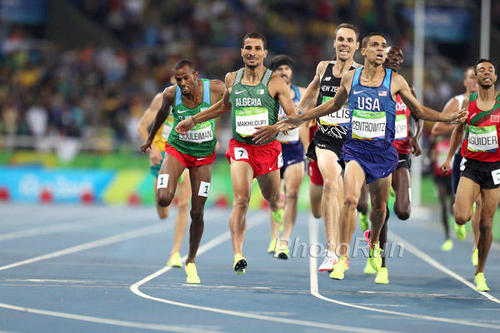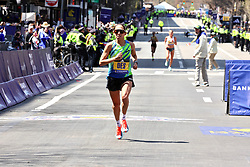 Matt Centrowitz breaks the U.S. drought at 1,500 meters! photo by PhotoRun.net
Matt Centrowitz breaks the U.S. drought at 1,500 meters! photo by PhotoRun.net
Updated December 11, 2016
After spending the last two weekends with the next generation of American distance runners, and chatting with the likes of Molly Huddle, Emily Sisson, Emma Coburn, and Boris Berian, I decided to rerun this piece so that we can truly consider how amazing American middle distance running has become. A conversation yesterday with Kim Conley reminded me how amazing the women distance runners we are watching now truly are. I was so impressed how Kim Conley came back from a tough 10,000m at the Trials and how she is focused on the future. Amazing athletes, amazing people. Read this piece by Orrin Konheim on our successes in 2016!
The performances of the U.S. middle and long distance team was one of the amazing themes for success at the Rio Olympics for the U.S. Orrin Konheim approached us about some insights into the succees of American distance running and why he thinks it will continue.
The ability of American distance running to keep pace with that of East Africa has slowed down significantly in the latter half of the 20th century. Everr since Ethiopian Abebe Bikila’s 1960 Olympic Marathon win and Kenyan Kip Keino upset US world record holder Jim Ryun in the 1968 Olympics, distance running has been the domain of East Africans.
In 2001, three remarkable athletes emerged–Alan Webb, Ryan Hall, and Dathan Ritzenheim–from the US high school running scene that would go onto break national records left and right. They sparked a renewed resurgence in American distance running, but it could be said that it has taken 15 years for their dominance to catch up to Olympic glory. Seven members of the US team are leaving Rio with medals in distance events.
Beyond that, there is plenty more to mark the progression of distance running in 2016 alone: Molly Huddle in lowering the American record in the 10K, Boris Berian and Eric Slowinski getting gold and bronze in the world indoor 800, and the continued ascendancy of Shannon Rowbury, Alyssa Montano, Molly Ludlow and Brenda Martinez as world-class in the 800 and 1500. (Shannon Rowbury ended the season with the 5000m AR).
In the six distance events- 800 m, 1500 m, 3K steeplechase, 5K, 10K, and[ marathon- the US has only managed five medals in the 21st century: Deena Kastor’s bronze in the 2004 marathon, Meb Keflezighi’s bronze in the 2004 marathon, Shalane Flanagan’s bronze in the 2008 10K race, Leonel Manzano’s silver in the 2012 1500 meter race and Galen Rupp’s silver in the 2012 10K race.
In Rio, the proof was in the pudding: Seven distance athletes medaled. Alan Webb himself said in a post-Olympics interview: “Somewhere along the way, we hit this critical tipping point where it really clicked. Now, every time an American steps to the line at an international competition they aren’t just saying they believe it. It’s inside they know it. It’s part of our culture now.”
Galen Rupp-Bronze, Marathon-The Home-Grown Prototype-Rupp was plucked as an Oregon high schooler by revered American marathoner and distance guru Alberto Salazar to be his protégé. Seeking to return the U.S. to its glory days of distance running, Salazar started the Nike Oregon Project in 2001 with Rupp being associated with the program from early on. Rupp ran in the program full-time in the first year after his high school graduation in 2004 (where he had a distinguished state- and national-record breaking) and his first season of University of Oregon eligibility in the Spring of 2005 where Salazar continued consulting with him on his training while he ran at the University of Oregon. In the past five years or so, he has become the dominant runner for US distance running. As such, his ascendancy has been coupled with controversy and he has been associated with the mainstream establishment more than any runner.
Eliud Kipchoge, Lilesa and Galen Rupp, Rio 2016, photo by PhotoRun.net
Paul Chelimo-Silver, 5K-Imported Talent-Chelimo was one of a number of Kenyans in the last couple decades who have come to American colleges on running scholarships and dominated at the NCAA while getting an education. He was among the top distance runners in his college years at UNC-Greensboro although he never won an NCAA title. Chelimo’s flag-jumping would not have happened a few years ago if it were not for the expansion of US Army’s World Class Army Program under distance coach Dan Browne (a West Point grad and 2004 Olympian) in recent years which fast-tracked the citizenship of Kenyan expatriates wishing to stay in the US after their college visas expired. As Chelimo put it, “If I go to the Army, I’ll forget about looking for money for upkeep. The only thing I have to focus on is the Olympics and qualifying for the Olympics and representing the U.S. Army in the Olympics.” Still, Chelimo was a massive underdog to make the US team and an even bigger one to medal. He lowered his own personal best 16 seconds en route to nabbing the silver
Paul Chelimo, photo by PhotoRun.net
RelatedPosts
Evan Jager-Silver, 3K Steeplechase-The Professional Maverick-Jager was recruited into one of the college scene’s best distance programs, the University of Wisconsin, only to drop out after his first year of eligibility to go professional in 2009. College athletes sacrificing their NCAA eligibility to go professional isn’t rare for those who have been so dominant that they need a higher level of competition. However, Jager only placed 8th at the NCAA championships in his first year. In Jager’s case, Wisconsin Coach Jerry Schmacher was recruited to the Nike Oregon Program (operating on the same campus as the above-mentioned Salazar) to train professional runners and Jager chose to follow him.
Although somewhat of an unprecedented move, Jager adapted and slowly crept his way up the ranks of the 1500 and 5K before finding his niche in the 3K Steeplechase just in time for the 2012 Olympics where finished 6th in the final. As Cait Chock reported on this site in 2014, much of Jager’s training has been steeple-specific under the guidance of Schumacher who’s long-standing relationship with him helped him know his strengths in the sport. For the past four years, Jager has been nipping on the heels of the dominant Kenyans before breaking through in this go-around with a medal. (Editor’s note: Kudos also to Pascal Dobert, assistant coach under Jerry Schumacher for Jager’s finely honed steeple form).
Evan Jager, photo by PhotoRun.net
Matt Centrowitz-Gold, 1500 run-The Prodigal Son and Master Tactician-Centrowitz was a gifted cross-country runner who developed a knack for tactical racing while at the University of Oregon. His breakout moment was in the summer of 2011 when he upset Bernard Lagat at the US World Championship trials and further surprised the field by getting a bronze at the World Championships in Daegu that year. Centrowitz hasn’t made a name for himself by breaking records, although his PRs have gradually improved to the point where a record is not out of reach. Instead, but rather for being a master tactician an being able to outmaneuver his opponents to the point where his competitors know he is a threat to win at any point of the race. Centrowitz told the Washington Post that in his planning, he had “a handful of strategies he had been mulling over, and he didn’t settle on his approach until reaching the starting line.”
What also has distinguished Centrowitz is his drive. His father is an American record holder and was an Olympian at Montreal who qualified for Moscow but wasn’t able to compete because of the boycott. After finishing fourth at London by less than a tenth of a second, Centrowitz has trained for the last four years with a vengeance to win a medal in the family name.
Matt Centrowitz, photo by PhotoRun.net
Clayton Murphy-Bronze, 800m-The Young Upstart -The 21-year-old University of Akron junior has gone from the bottom rungs of Division I to a world class runner in 2015 (4th at US nationals, marginal qualifier to the World Championships, Gold medalist at the less competitive Pan American games) to practically unstoppable in 2016. While he began this season with a PR three seconds away from the eventual Gold medal-winning time, his finishing kick has appeared to know no bounds as he was undefeated in 2016 going to the Olympic games. Murphy told RunBlogRun earlier this year that although he is very goal-oriented, he is just as surprised himself at how far his upper limit extends, “I think at some point I knew that I had it in me. I knew I wasn’t training at the level I could, but I had no clue what I could do.” Murphy dipped under 1:45 at the Olympic trials to edge out Boris Berian at the line. When necessity demanded he go faster to stay in medal contention at the Olympic finals, Murphy broke 1:43 to maintain his position for a surprise bronze.
Clayton Murphy, Taoufik Maklhoufi, David Rudisha, photo by PhotoRun.net
Jennifer Simpson-Bronze, 1500m-The Consummate Veteran-One of the most consistently elite performers in American distance running, Simpson is appearing in her third Olympics and already carries two World Championship medals to her name. She was an all-American and NCAA steeplechase champion (she qualified for Beijing in the steeplechase) before focusing on the mile after nearly setting an American record at the Prefontaine Invitational before her first Olympics. Trading titles with US Olympic teammate Shannon Rowbury (Rowbury holds the American record, Simpson held the world title in 2011, silver in 2013), Simpson has faced elite competition at home and abroad for some time to the point where it became more and more of an inevitability that the longer she raced on the scene, the better chance she had of medaling at an opportune moment.
Jenny Simpson, photo by PhotoRun.net
Emma Coburn-Bronze, 3K Steeplechase-The First of Her Generation- The women’s steeplechase was run at the NCAA and USATF outdoor championships but didn’t have the popularity to make it onto the Olympic schedule until 2008. At the University of Colorado, the above-mentioned Jennifer Simpson (then known as Jennifer Barringer) was pushing the boundaries forward in the event by setting an American record and qualifying for Beijing shortly after. A rugged multi-sport high school senior from Crested Butte, Colorado drew inspiration from Barringer’s progress. By that time, Coburn had found her love of the steeplechase since her first time trying it her junior year. “It was a challenge that gave me something to focus on other than the misery of running lap after lap. I liked the adventure of it,” she said in a 2015 interview.
Coburn placed 2nd at the 2008 National Outdoor Championships in the high school steeplechase before going to Colorado where she trained alongside steeplechase superstar Shalaya Kipp (who would eventually make the London Olympics as well) and won two steeplechase titles and a trip to London during her tenure as a Buffalo. She has run in several elite miles, but at this point her experience in the steeplechase extends to nearly ten years of intensive specialization which few of her competitiors can boast in a discipline that’s only been an Olympic-level sport for eight years.
Emma Coburn has lowered the American record twice this year, (the previous record held by her team mate Jenny Simpson) she also leads a growing contingent of Americans excelling at the event. In 2016, four women ran under the 9:22 mark and all four ranked among the world’s top 15.
Emma Coburn, photo by PhotoRun.net
Orrin Konheim is a freelance journalist and writer as well as an Olympics and track and field enthusiast who’s writing credits with regard to running include Mental Floss Magazine, Run Washington Magazine and Today I Found Out.





















